
Manufacturer's Specifications:
Frequency Response: 2 Hz to 20-KHz, ±0.3 dB.
S/N: Greater than 117 dB.
Dynamic Range: Greater than 100 dB.
THD: 0.0015%.
Channel Separation: Greater than 110 dB.
Wow and Flutter: Below measurable limits ( ± 0.001% wtd. peak).
Analog Output Levels and Impedances: Unbalanced, fixed, 2.0 V/10 kilohms; variable, 0 to 2.0 V/50 kilohms; balanced, 2.0 V/10 kilohms; headphone, 40 mW/32 ohms.
Digital Output Levels and Impedances: Coaxial, 0.5 V peak to peak, 75 ohms; optical, -18 dBm (660-nm wavelength).
Number of Programmable Items per Disc: 20.
Power Requirements: 120 V a.c., 50/60 Hz, 22 watts.
Dimensions: 18 5/8 in. W x 5 in. H x 14 5/8 in. D (47.2 cm x 12.7 cm x 37.1 cm).
Weight: 37.4 lbs. (17 kg).
Price: $1,700.
Company Address: Sony Dr., Park Ridge, N.J. 07656.
Every time I think I have come up with a reference CD player in the under-$2,000 price category, along comes Sony with a next-generation player that surpasses my choice on just about every count. Such was the case with the CDP-X77ES, which is Sony's successor to the ac claimed CDP-X7ESD, my previous selection as a reference player.
The refinements and enhancements in the CDP-X77ES include innovations and improvements in circuitry as well as user convenience features. Like many new CD players, this unit embraces what many call "one-bit" D/A technology (a bit of a misnomer, but not a serious one). Much has been written concerning the advantages of one-bit D/A conversion (which uses techniques developed by NTT, the Nippon Telegraph and Telephone Corp.), so I won't spend time detailing its principles except to say that such converters can theoretically be free of several problems associated with conventional, step-waveform D/A converters. These problems include differential nonlinearity distortion, zero-crossing distortion, and glitches caused by minute timing differences between the various bit switches. Sony's version of one-bit technology, which they call a High Density Linear Converter System, consists of a noise-shaping digital filter, a new "pulse D/A converter," and an analog low-pass filter.
Noise-shaping filters are integral to the design of one-bit converters. Since such converters operate on one bit at a time, instead of all 16 bits simultaneously, the bit rate must be reduced to be practical with today's IC technology.
Noise shaping permits this bit reduction to be done without loss of audible dynamic range, by shifting much of the noise up to inaudible frequencies. In the CDP-X77ES, Sony em ploys a third-order filter system that operates at a 64-times oversampling rate.
While the output of a conventional D/A converter is a stepwise version of the original analog signal, the output of a pulse D/A converter consists of a train of pulse-length modulated (PLM) pulses which, like the stepwise outputs of other D/A circuits, can be converted to a smooth analog wave by a high-pass analog filter. To raise the pulse density for higher accuracy, the converter uses a clock generator that operates at a maximum of 50 MHz, about twice as high as that of ordinary high-speed C-MOS ICs. To eliminate minute, secondary distortion components that would show up predominantly when reproducing higher audio frequencies, Sony uses two pulse D/A converters per channel in complementary mode.
Since a pulse D/A converter defines musical signals by altering pulse density, it is important to time those pulses precisely to ensure conversion accuracy. Sony uses a Direct Digital Sync circuit to accomplish this. The circuit was incorporated in last year's players as a separate IC, but has now been integrated into the new HDLC IC, enabling direct connection of a highly accurate quartz-oscillator master clock to the PLM pulse converter.
By using these techniques, Sony claims to have achieved a theoretical S/N ratio of 124 dB! These enhancements also contribute to what I found to be amazingly low residual distortion in the CDP-X77ES.
Custom Edit and Custom File, two convenience features which take advantage of the subcodes found on all CDs, are used here, as they were in earlier Sony players. Custom Edit makes it easy to calculate how many selections can fit on a cassette of given length. As you program the player, the time display shows the total accumulated time that you have programmed. A manual fade feature lets you smoothly fade a selection digitally if you must use up the last bit of tape while transcribing a CD, so that when it is played back, there is no abrupt interruption in sound as you come to the end of one side of the tape. Custom File lets you store your programming choices for a disc in a "program bank" so that you can call up the program whenever you play that disc again. Every time you insert the disc, the player can recall your selections and play them in the order you had previously selected. Of course, such features as shuffle play, single play, and the various types of repeat play are also available.
Control Layout
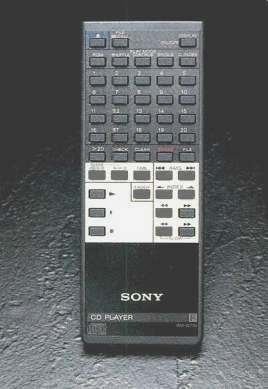
Remote control
Most of the special features just described are accessible only from the supplied remote control, so as to keep the front panel's layout relatively uncluttered. The main power switch, the headphone jack, and the level control (which affects both the headphone and variable line outputs) are at the left end of the pane . Nearby is the smoothly operating disc tray, and below it is a large display area. In addition to the usual displays of elapsed or remaining time and track and index numbers, this display shows playback mode ("Program Bank," "Single," and "Repeat A-B"), the presence of a disc, and "Custom Index" status.
Immediately to the right are the "Display On/Off' and drawer "Open/Close" buttons. At the upper right of the panel is the button for selecting analog or digital output, with a pair of indicator lights to show the current output mode.
Track advance and reverse buttons (Sony calls them "AMS," for Automatic Music Search), fast forward and re verse search buttons, and the usual play, stop, and pause buttons complete the panel layout.
The remote control's keys duplicate all of the controls found on the front panel, even including the disc tray open/ close function. In addition, there are 20 numbered buttons for instant track access and programming. If a disc contains more than 20 tracks, a ">20" button takes care of accessing the higher numbered tracks. Buttons for indexing, re peat play, and all playback modes (program, shuffle play, single track, custom index, and continuous play) are found on the remote, as are buttons labeled "File," "File Recall," "Erase," program "Clear," and "Check" (to review a pro gram you have assigned to a disc). While the fast-search buttons on the front panel allow audible searching at a fairly rapid speed, the remote has two sets of search buttons. The search speed initiated by the first set is the same as that initiated by the front-panel buttons, but the second set, labeled "Slow," reduces the speed of the audible search.
The rear panel of the CDP-X77ES is equipped with coaxial and EIAJ Standard optical digital output jacks, balanced analog output XLR connectors, and fixed and variable unbalanced RCA output jacks.
Measurements

Fig. 1-Frequency response, from 10 Hz to 20 kHz, for left channel (solid
curve) and right channel (dashed curve).
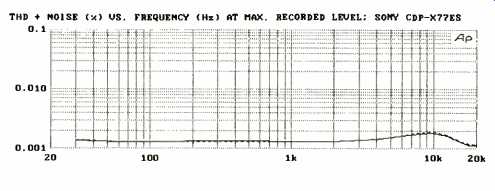
Fig. 2-THD + N vs. frequency for left channel (solid curve) and right channel
(dashed curve).

Fig. 3-THD + N (referred to 0-dB recorded level) vs. signal amplitude for
left channel (solid curve) and right channel (dashed curve).
Figure 1 shows the frequency response of this player, from 10 Hz to 20 kHz. Deviation from flat response never exceeded 0.07 dB, even at 20 kHz, where most CD players begin to have some roll-off. Of course, a slight deviation or roll-off at 20 kHz would hardly be cause for concern, so the flatter frequency response of the CDP-X77ES may not be a contributing factor to its superior sound quality.
I am convinced, however, that the distortion measurements I obtained do show some of the reasons why this player sounds as good as it does. Consider Fig. 2, the plot of THD + N. When have you seen distortion in a CD player test report that never exceeded 0.002%, even at the high end of the frequency spectrum? And at 1 kHz, THD + N was an even lower 0.0013%. This level of THD + N (relative to maximum recorded level) is maintained or bettered at all playback levels, from 0 dB (maximum) down to-90 dB, as shown in Fig. 3. A further check was done using the FFT spectrum analysis capability of the Audio Precision System One, and the results for a 1-kHz, high-level signal are shown in Fig. 4A. The tall spike at the left represents the desired 1-kHz output. The test was repeated for a recorded level of -60 dB, and results are shown in Fig. 4B. The spike at the left is the new reference and corresponds to the recorded level of -60 dB, so as you can see, noise and distortion components of the CDP-X77ES are approximately at the 0.1% point relative to -60 dB signals! This corresponds to 60 dB below the -60 dB point, or -120 dB relative to a maximum-level signal.
Sony makes a point of the fact that their new D/A conversion system is particularly good at reducing distortion components normally associated with high-frequency program content. I was already pretty well convinced of this after examining the results in Fig. 2, but to further prove the point, played back a maximum-level, 10-kHz signal from my CBS CD-1 test disc and did another spectrum analysis of the output. Results are shown in Fig. 5. No band limiting was used and the sweep was extended out to 80 kHz, which was sufficient to show how low the harmonic components associated with a 10-kHz playback signal were. I also made spot tests of SMPTE-IM distortion, using a maximum-level re corded signal; IM was 0.003% on the left channel and 0.0027% on the right. Even clock-frequency accuracy was better than I have ever measured. It was off by a mere-0.0006%, which corresponds to a 440-Hz musical tone being reproduced as 439.99736 Hz-not particularly "off key" by even the most stringent standards! When playing the "no-signal" track of the CBS CD-1 test disc, I obtained a remarkably low A-weighted signal-to noise ratio of -123 dB on the left channel and -123.4 dB on the right. I believe this is a new record for a CD player.
Furthermore, a spectrum analysis of the residual noise, which can be seen in Fig. 6, showed that even at the power-supply frequency, noise was still more than 130 dB below maximum recorded level. Channel separation at 1 kHz was also superb, 188 dB from left to right channel and 111 dB from right to left; even at 20 kHz, separation was 100 dB or more.
Having studied the literature concerning Sony's new High Density Linear Converter System in some detail, I was not surprised that this player's linearity was the best I have ever measured. As shown in Fig. 7, deviation from linearity for non-dithered signals was about + 0.65 dB for signals at the -90 dB level; for dithered signals it was closer to zero even at -100 dB-than I have seen for any CD player, regardless of price! The fade-to-noise test, conducted as an additional check, served to confirm the incredible linearity achieved by the CDP-X77ES. As Fig. 8 shows, there was virtually no departure from perfect linearity, right down into the residual noise level at -120 dB. The EIA dynamic range reading that this plot enabled me establish was about 115 dB-which, by the way, is the theoretical maximum for CD players. Using the EIAJ method for measuring dynamic range, I obtained a value of only 100 dB, the figure that Sony claims. I presume, therefore, that Sony used the EIAJ's method to obtain the published spec.
My one remaining test, viewing the player's output for a unit pulse signal, showed that the CDP-X77ES does not invert polarity of recorded signals.
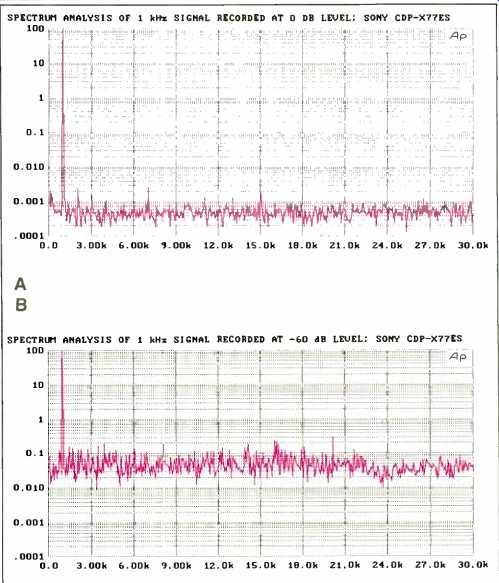
Fig. 4--Spectrum analysis of 1-kHz signals recorded at 0-dB, or maximum,
level (A) and at- 60 dB (B).
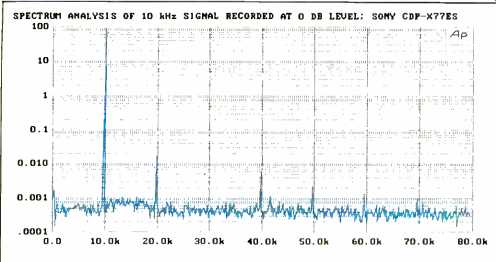
Fig. 5--Spectrum analysis of 10-kHz signal recorded at 0-dB (maximum) level.
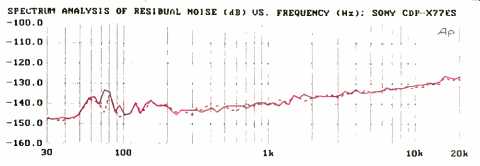
Fig. 6--Spectrum analysis of residual noise for left channel (solid curve)
and right channel (dashed curve).

Fig. 7--Deviation from linearity for undithered signals from-90 to 0 dB
and for dithered signals from-100 dB up.
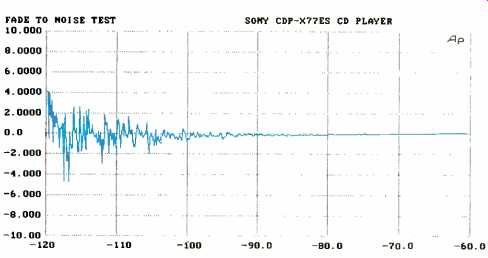
Fig. 8-Fade-to-noise test.
Use and Listening Tests
I was, of course, intrigued by the Custom File and Custom Edit features of this player, but before I started using them and before I set aside the test instruments and addressed the ultimate question about how music sounded when re produced by this player, I wanted to check out its ability to handle discs with severe dropouts. The Sony's tracking ability and resistance to external vibration were as impressive as its lab measurements. The CDP-X77ES was able to play through dropouts 1.5 mm in length without so much as an audible glitch. Even when track pitch was reduced to the minimum allowed by the CD Standard, the player still was able to handle such long dropouts; when successive drop outs of that length were played, they too were handled by this player as though the digital data was unimpaired.
I chose two recent CD releases for my initial listening tests. The first was a Telarc recording, Beethoven: Piano Sonatas Nos. 1, 2 & 3, Op. 2 (CD-80214), played by John O'Conor. It is no secret by now that recording a piano digitally and having it reproduced so that it sounds like a real piano is not easy. Yet this recording, played on the Sony, came as close to realizing that goal as anything I have ever heard. What's more, as good as the recording is, I found that when it was used with two other CD players in the lab, the piano lacked some of the detail and took on a somewhat "colder" sound, with some of the subtler shadings of O'Conor's playing no longer distinguishable.
For contrast, the second CD I chose was a Delos release (DE-3083) featuring the Seattle Symphony, conducted by Gerard Schwarz, playing the complete ballet music from Bela Bartok's The Miraculous Mandarin and selections from Zoltan Kodaly's opera Hary Janos. Another selection on this disc, "Galanta Dances," also by Kodaly, features solo clarinetist Christopher Sereque. It was this last selection that impressed me particularly. I was able to clearly separate the mellow, smooth clarinet sounds from the rest of the orchestral structure even when both elements of the music were interwoven-something I found difficult to do as well when the same disc was played on other machines.
Needless to say, I played a wide assortment of other discs on the CDP-X77ES. While listening to all of this musical fare, my thoughts could not help wandering back to the beginning of the CD player era, and then to the players that I tested as recently as a few months to a year ago. I thought back to the superlatives I had used in my reports on earlier players and wondered how I could top them, in words, as Sony has managed to top its own earlier players, in technology. My most recently acclaimed player, the Sony CDP X7ESD, was tested for Audio less than a year ago (November 1989). That player was actually more costly, proving that, if it's executed properly, one-bit technology, by what ever name, not only results in superior D/A conversion but--all other things being equal--actually results in cost savings as well. So now the CDP-X77ES replaces the CDP-X7ESD as the player that others will have to challenge-at least in my laboratory and listening room. What a difference another "7" has made!
-Leonard Feldman
(Source: Audio magazine, Jun. 1990)
Also see:
Sony CDP-X7ESD CD Player (Nov. 1989)
Sony CDP-620ES CD Player (Sept. 1985)
Sony CDP-610ES CD Player (Nov. 1984)
Sony CDP-650ESD Compact Disc Player (July 1985)
= = = =